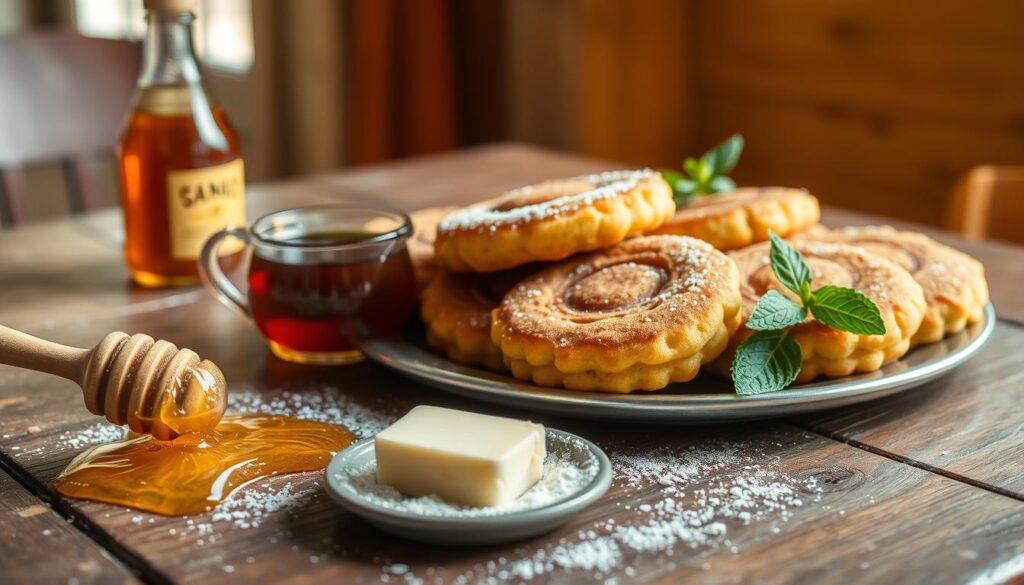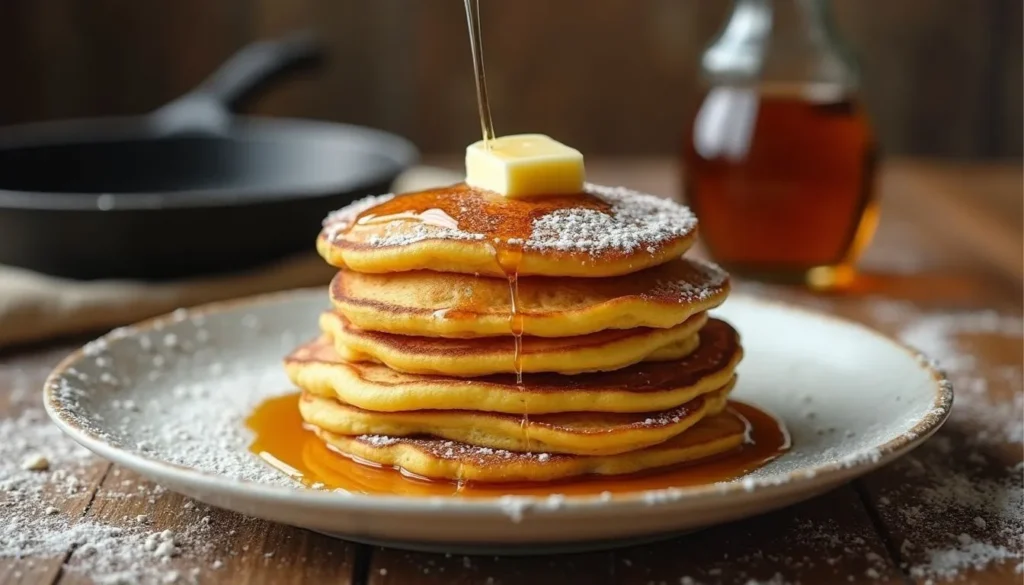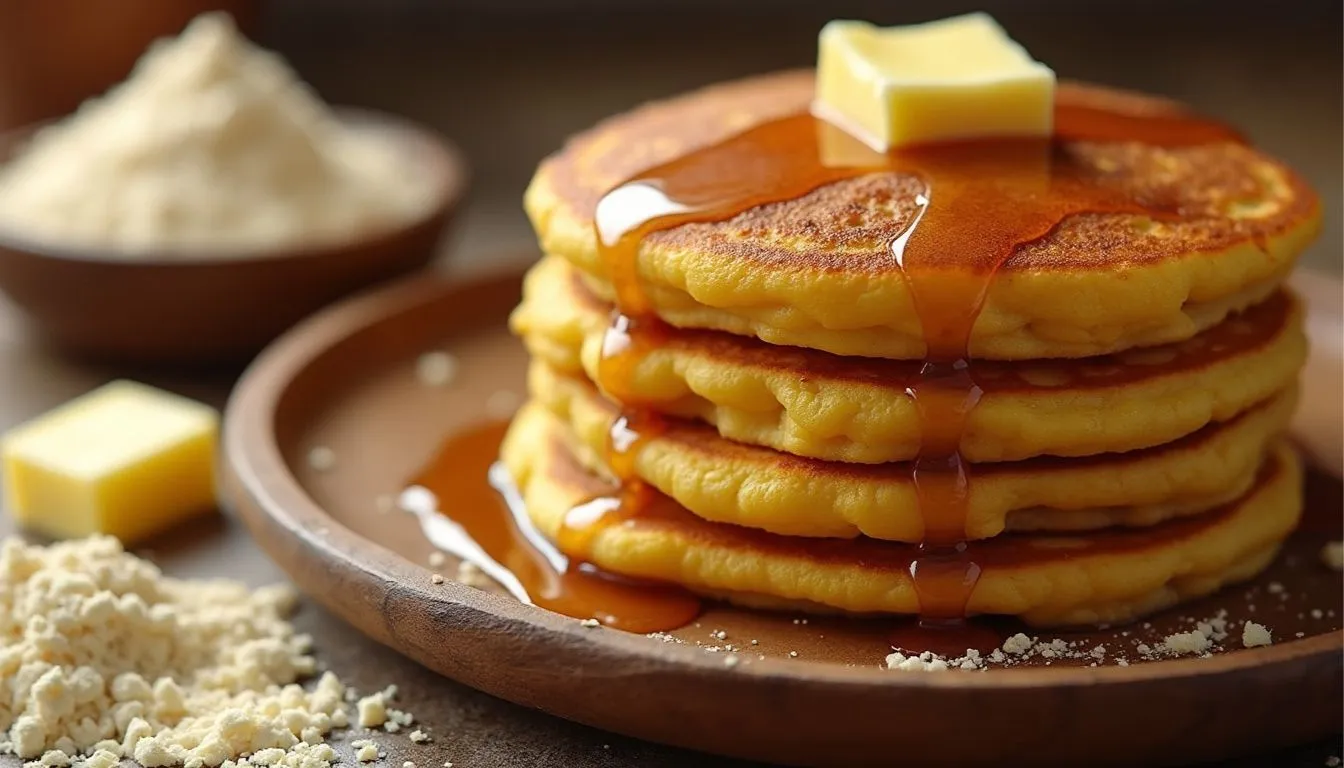Growing up in the South, I remember the warm kitchen filled with the comforting aroma of sizzling hoe cakes. These golden, crispy discs were more than just a meal. They were a connection to generations of family tradition. Your first bite of a perfectly crafted hoe cakes recipe transports you to a world of simple, heartwarming flavors.
Hoe cakes represent more than just a simple dish. They’re a testament to Southern resourcefulness and culinary creativity. Imagine a food so versatile it can be a hearty breakfast, a side dish, or even a quick snack that brings families together around the table.
Whether you’re a seasoned Southern cook or someone curious about traditional American cuisine, this guide will walk you through everything you need to know about creating these delectable treats in your own kitchen.
Understanding the Southern Heritage of Hoe Cakes
Hoe cakes are more than a simple breakfast dish. They are a deep part of the soul food culture in the American South. These flatbreads tell a story of resilience, creativity, and survival across generations.
The history of hoe cakes is tied to the Southern United States’ agricultural landscape. Enslaved African Americans and poor farming communities created this meal with limited resources.
Origins and Historical Significance
Hoe cakes started in the early colonial period. They were a practical meal for hungry field workers. The name shows a clever cooking method:
- Slaves and farm workers used the flat side of a hoe to cook
- They heated the hoe over an open fire
- Cornmeal batter was poured onto the hot metal
Why They’re Called Hoe Cakes
The term “hoe cake” comes from the tool used to cook them. Agricultural workers cooked their bread on the blade of a hoe. This made a crispy, golden-brown treat for long workdays.
Cultural Impact in Southern Cuisine
Hoe cakes have grown beyond their simple beginnings. They are a cherished part of soul food. They show the resourcefulness and culinary creativity of Southern communities.
| Era | Cultural Significance |
|---|---|
| Colonial Period | Survival food for farm workers |
| 19th Century | Staple in enslaved communities |
| Modern Day | Celebrated soul food tradition |
Today, hoe cakes are a beloved part of Southern breakfasts. They connect generations through a simple yet meaningful culinary practice.
Essential Ingredients for Traditional Hoe Cakes
Making delicious buttermilk hoe cakes starts with the right ingredients. Your journey to authentic Southern cornmeal pancakes begins with understanding each component. Each part plays a key role in creating the perfect texture and flavor.
The heart of classic hoe cakes lies in a few key ingredients. These ingredients turn simple pantry staples into a delicious dish. Let’s look at the essential elements that make these traditional cornmeal pancakes stand out:
- Cornmeal: The star ingredient that provides a rich, distinctive flavor and signature grainy texture
- All-purpose flour for structure and lightness
- Baking powder to help the buttermilk hoe cakes rise
- Salt to enhance overall taste
- Fresh buttermilk for tangy tenderness
- Eggs for binding and richness
- Cooking fat (bacon grease or oil) for authentic Southern flavor
Choosing high-quality ingredients is key to great cornmeal pancakes. Use stone-ground cornmeal for a more authentic taste and texture. Fresh, full-fat buttermilk will give you tender and flavorful hoe cakes. These capture the essence of Southern cooking.
Pro tip: For the most authentic buttermilk hoe cakes, use cast-iron skillet-rendered bacon grease instead of modern cooking oils.
The Perfect Hoe Cakes Recipe: Step-by-Step Guide
Making delicious hoe cakes is an art. It mixes simple ingredients with Southern cooking techniques. This guide will show you how to make tasty cornmeal fritters in your kitchen.
Preparing the Batter
Your hoe cakes recipe starts with the right ingredients. You’ll need:
- 1 cup stone-ground cornmeal
- 1/2 cup all-purpose flour
- 1 teaspoon baking powder
- 1/2 teaspoon salt
- 1 cup buttermilk
- 1 large egg
- 2 tablespoons melted butter
Mix the dry ingredients in a large bowl. Whisk the wet ingredients separately. Then, combine them gently. Let the batter rest for 10 minutes. This step makes the cornmeal fritters richer in flavor.
Cooking Temperature and Timing
Heat a cast-iron skillet over medium-high heat. Add a thin layer of oil or butter. The right temperature is around 375°F for perfect hoe cakes.
Scoop about 1/4 cup of batter for each cake. Cook for 2-3 minutes until they’re golden brown. Flip them and cook the other side for 2 more minutes.
Testing for Doneness
Your hoe cakes are done when they’re golden brown and crispy. The inside should be soft but fully cooked. Use a fork to check the texture—it should be light and fluffy.
Pro tip: Let the cakes rest on a paper towel to absorb excess oil and keep their crisp texture.
Choosing the Right Cooking Equipment
Choosing the right cooking equipment is key when making traditional southern cornbread or griddle cakes. The classic choice for generations of Southern cooks is the cast iron skillet. It turns simple ingredients into crispy, delicious treats.
Cast iron skillets distribute heat well and keep it, making your hoe cakes golden-brown. They are durable and get a non-stick surface with seasoning. This makes them a must-have in your kitchen.
- Cast iron skillet: Best for traditional griddle cakes
- Non-stick griddle: Modern alternative with easy cleaning
- Heavy-bottomed pan: Suitable backup option
When picking your cooking surface, think about these important factors:
- Heat conductivity
- Surface evenness
- Maintenance requirements
- Cooking performance
Pro tip: A well-seasoned cast iron skillet not only enhances flavor but also provides superior cooking results for your southern cornbread and griddle cakes.
The right pan can transform good griddle cakes into exceptional culinary memories.
Traditional vs Modern Preparation Methods
Southern breakfast traditions have changed, introducing new ways to make cornbread pancakes. The method you use can greatly affect their taste and feel.
Cooking hoe cakes has moved from simple campfire methods to many modern ones. Your choice of cooking method can make your southern breakfast even more authentic.
Cast Iron Skillet Technique
The traditional cast iron skillet is the top choice for cornbread pancakes. It has many benefits:
- It distributes heat evenly
- It makes the pancakes crispy and golden
- It adds a special flavor from the seasoned skillet
- It keeps the true southern cooking spirit alive
Alternative Cooking Methods
Modern kitchens offer many ways to cook your favorite southern breakfast cornbread pancakes:
- Electric Griddles: They keep the temperature steady
- Non-stick pans: They’re easy to clean and use less oil
- Outdoor flat-top grills: Great for big groups
Each method gives your cornbread pancakes something special. Your cooking surface can change how they taste and feel, making this southern dish even more enjoyable.
Serving Suggestions and Pairings

Southern cornbread’s cousin, hoe cakes, add excitement to your meals. These crispy, golden treats bring a rich flavor and a piece of soul food history to your table.
Breakfast fans will love hoe cakes with tasty toppings. Try these:
- Warm butter and drizzled honey
- Fruit preserves or homemade jam
- Maple syrup with a sprinkle of cinnamon
- Scrambled eggs and crispy bacon
For those who love savory dishes, hoe cakes are a great side. Pair them with classic Southern proteins for a true soul food meal:
- Crispy fried chicken
- Collard greens with ham hocks
- Black-eyed peas
“Hoe cakes are more than just bread—they’re a culinary tradition that connects generations.” – Southern Food Historian
Get creative with hoe cakes. Use them as appetizer bases or sandwich bread. Their versatility makes them a joy to include in any meal, linking past and present in Southern cooking.
Tips for Achieving the Perfect Texture
Making the perfect hoe cakes recipe takes skill and patience. The texture of your cornmeal fritters can turn a simple dish into a masterpiece.
To master hoe cakes, you need to know how to prepare the batter and cook it right. Aim for a golden-brown outside and a soft, light inside that’s a joy to eat.
Common Mistakes to Avoid
- Overmixing the batter, which can create tough cornmeal fritters
- Using cold ingredients that prevent proper ingredient integration
- Cooking at incorrect temperatures that lead to uneven browning
- Neglecting to let the batter rest before cooking
Troubleshooting Guide
| Problem | Solution |
|---|---|
| Dense, heavy hoe cakes | Reduce mixing time and use fresh leavening agents |
| Greasy texture | Ensure oil is at correct temperature (around 350°F) |
| Uneven cooking | Use a consistent heat source and flip only once |
For the best hoe cakes, patience is key. Let your batter rest for 10-15 minutes. This lets the cornmeal soak up the liquid, making the texture smoother.
Pro tip: Use a cast-iron skillet for the most authentic and evenly cooked cornmeal fritters. The even heat distribution will help you achieve that perfect golden-brown crust every time.
Sweet and Savory Variations

Your southern breakfast can get a boost with creative cornmeal pancakes. They mix old-school methods with new flavors. You can go for something sweet or savory, making pancakes a fun adventure in the kitchen.
For savory cornmeal pancakes, try these tasty mix-ins:
- Shredded cheddar cheese
- Chopped green onions
- Diced jalapeños
- Fresh herbs like thyme or rosemary
For sweet cornmeal pancakes, add these ingredients:
- Blueberries or raspberries
- Caramelized bananas
- Maple syrup drizzle
- Cinnamon and nutmeg spice blend
- Honey and toasted pecans
Pro tip: When adding ingredients to your cornmeal pancake batter, adjust liquid quantities to maintain the perfect consistency. Wet ingredients like fruit might require slightly less liquid, while dry additions like cheese might need a touch more.
Try out these variations to find your top pick. Cornmeal pancakes are great because they can be anything you want. They’re a blank slate for your cooking dreams.
Storage and Reheating Guidelines
Keeping your homemade hoe cakes fresh is key. Whether you’ve made a batch of traditional southern cornbread-style hoe cakes or have leftovers, knowing how to store and reheat them is important. This helps keep their authentic flavor and texture.
Proper Storage Methods
Storing your hoe cakes correctly is easy. Follow these tips to keep them fresh:
- Store cooled hoe cakes in an airtight container
- Refrigerate for up to 4 days
- For longer storage, freeze for up to 3 months
- Place parchment paper between layers to prevent sticking
Best Reheating Practices
Reheating your hoe cakes right is important. Here are some good ways to do it:
- Skillet Method: Warm on medium-low heat with a touch of butter
- Oven Reheating: Warm at 350°F for 5-7 minutes
- Toaster Oven: Heat for 2-3 minutes until crisp
Pro tip: Don’t microwave your hoe cakes. It can make them soggy and less tasty. Always try to get them back to their crispy texture when reheating.
Health Considerations and Dietary Adaptations
Buttermilk hoe cakes can be good for you if you choose the right ingredients. Traditional recipes might seem too rich, but you can make them healthier. This way, they fit different diets well.
Looking into dietary changes lets you enjoy buttermilk hoe cakes without losing flavor or nutrition. Here are some smart tweaks:
- Gluten-free flour options like almond or coconut flour
- Plant-based milk substitutes for lactose-intolerant individuals
- Reduced-fat alternatives using Greek yogurt
- Whole grain flour for increased fiber content
When making cornbread pancakes, think about what you’re putting in them. Choosing good ingredients makes the dish better for you.
For people with certain diets, hoe cakes are very adaptable. Vegans can use flaxseed meal instead of eggs. Those watching calories might bake instead of fry.
Changing ingredients can really change how healthy buttermilk hoe cakes are. Try different options to find a version that fits your diet. Yet, keep the dish’s Southern flavor.
Conclusion
Hoe cakes are more than a simple dish in Southern cuisine. They show the rich culinary heritage of soul food. They connect generations through a timeless recipe that speaks to creativity and resourcefulness.
Exploring Southern cornbread traditions, you’ll find hoe cakes are a cultural experience. They’re not just a meal. Whether you’re cooking them in a cast-iron skillet or trying new variations, these cakes let you connect with American culinary history.
Your kitchen can be a way to keep Southern cooking alive. Every batch of hoe cakes you make keeps a tradition alive. It shows that great food doesn’t need to be complicated. It just needs passion, skill, and respect for culinary roots.
Start making hoe cakes and remember each crispy, golden bite has a story. It’s about resilience, innovation, and the power of home-cooked meals to bring people together.
Tried Our Recipe Yet?
There are no reviews yet. Be the first one to write one.

